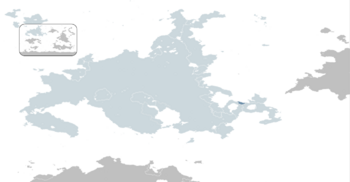Brynmor
Kingdom of Brynmor | |
|---|---|
| Motto: Oherwydd pan fyddwn yn uno, nid ydym yn stopio For when we unite, we do not stop | |
| Anthem: Yma o hyd We are still here. | |
 Brynmor Parthenia | |
| Capital and largest city | Marunath |
| Official languages | Brynnish |
| Recognised regional languages | Charmelcs, Anglish |
| Ethnic groups (2021) | Brynnish 88% Charmelcian 6.3% Anglican 4.1% Vermandois |
| Demonym(s) | Brynnish |
| Government | Unitary parliamentary constitutional monarchy |
• King | Llywelyn III |
| Rhys Griffiths | |
| Legislature | Senedd |
| Assembly of the Siambr | |
| Assembly of Commons | |
| Population | |
• 2022 estimate | 5,156,286 |
• Density | 140/km2 (362.6/sq mi) |
| GDP (PPP) | 2016 estimate |
• Total | $ 238.64 billion |
• Per capita | $ 21,034 |
| HDI (2020) | 0.833 very high |
| Currency | Brynnish Pence (BNP) |
| Internet TLD | .by |
The Kingdom of Brynmor (Brynnish: Teyrnas Brynymôr, Charmelcs: Rioghachd Cnocnamara), commonly known as Brynmor, is a sovereign state in Parthenia. It shares land borders with Angland to the east and Vermand to the west. On it's north coast is the Sea of Slethar. As of 2017, Brynmor's population was approximately 5.3 million. Its capital city is Marunath, which is also the largest city in the country.
Continuous habitation within the modern borders of Brynmor began during the neolithic period as one of the earliest inhabited regions of Parthenia. Early Celtic cultures began to appear in the bronze age and iron age, despite Remillian occupation later on, connecting Brynmor to the other Celtic nations of the Sea of Slethar. Unlike neighbouring Angland, the Remillian occupation had little effect on the culture and people groups of Brynmor, as Celtic culture continued to develop. Following the collapse of the Remillian Empire in 301 AD, Brynmor was split into two kingdoms, Battania and Reyvadoin. It is theorized that these kingdoms would assist eachother in defending their lands from the Livanic invaders from the west, using the hilly terrain to their advantage.
Etymology
History
Prehistory
Geography
Biodiversity
Climate
Politics and Government
Foreign Relations
Military
Administrative Divisions
Law
Law Enforcement
Economy
Primary sector
Secondary sector
Tertiary sector
Quarternary sector
Energy
Natural resources
Demographics
Urbanization
Immigration
Religion
Languages
Education
Healthcare
Culture
See Also
References
This article is incomplete because it is pending further input from participants, or it is a work-in-progress by one author. Please comment on this article's talk page to share your input, comments and questions. Note: To contribute to this article, you may need to seek help from the author(s) of this page. |
Currently a rump page to help set up overall templates that work on categories. Please do not delete, will be reworked



